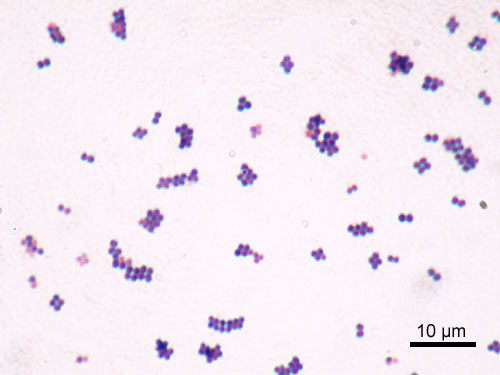Staphylococcus
Definition[edit | edit source]
So far, 40 species have been recognized.
Morphology[edit | edit source]
G + cocci in clusters, non-sporulating, immobile, mostly unencapsulated.
Metabolism[edit | edit source]
Positive catalase tests, facultatively anaerobic and aerobic.
Occurrence[edit | edit source]
On the skin and mucous membranes of humans and animals as part of the normal microflora.
Cultivation[edit | edit source]
Relatively undemanding to cultivation conditions, they grow on blood agar, liver broth.
Material collection[edit | edit source]
Clinical material from purulent infections, urine, cerebrospinal fluid, blood, faeces and sputum is collected for diagnosis.
Staphylococci are classified according to their ability to coagulate plasma by the plasma coagulase test into:
Coagulase positive - Staphylococcus aureus, Staphylococcus intermedius
Coagulase negative ("CoNS") - Staphylococcus epidermidis, S. saprophyticus, S. haemolyticus
Staphylococcus aureus[edit | edit source]
It is one of the most biochemically active species of bacteria, producing a wide range of exoenzymes and toxins. It is one of the most common causes of pyogenic infections and intoxications in humans and animals.
Diagnostic procedure[edit | edit source]
Material: urine, cerebrospinal fluid, sputum, blood
Identification:
- microscopy: G + cocci
- cultivation: KA (ocher colonies with beta-hemolysis)
- tests: positive plasma coagulase test
Serological methods: detection of TSST-1 and enterotoxin
Disease[edit | edit source]
During infection, it creates abscesses rather than phlegmon. It causes inflammation, abscesses, folliculitis, sinusitis, bronchopneumonia, sepsis. The human body is highly resistant to staphylococcal infections. However, it can occur during surgery, injury, or immunological failure. Due to considerable virulence, staphylococcal infections tend to recur or develop chronically. If bacteria enter the bloodstream from the lesion, secondary pneumonia, osteomyelitis or endocarditis may occur.
As already mentioned, staphylococci are among the most common causes of post-traumatic and post-operative infections. After 1 to 2 days of incubation, serous exudation occurs around the injured tissue. The inflammatory process rapidly changes into a pyogenic reaction followed by extensive necrosis and dehiscence of the wound. Sepsis and the development of pyogenic metastases are common complications. [1]
Other diseases are caused by toxins - toxic shock syndrome, staphylococcal enterotoxicosis.
Production of toxins and enzymes[edit | edit source]
TSST-1 (toxic shock syndrome toxin)
exfoliatin (causes scalded skin syndrome, SSSS, Ritter's syndrome)
enterotoxins
cytotoxins and leukotoxins
hyaluronidase
Therapy[edit | edit source]
Superficial infections heal spontaneously, deep infections require surgery and the use of antibiotics such as oxacillin. Currently, 80% of strains are resistant to penicillin. Semisynthetic beta-lactamase-resistant penicillins can solve this problem. [1]
Backup antibiotics, such as vancomycin and teicoplanin, are used to treat MRSA infections
MRSA[edit | edit source]
MRSA, methicillin-resistant Staphylococcus aureus, is the name for strains of Staphylococcus aureus that have acquired resistance to the antibiotic methicillin. The mecA gene, located on the staphylococcal chromosome cassette mec (SCCmec), which encodes the enzyme PBP2a (abbreviation for penicillin-binding protein), is responsible for resistance. This enzyme functions as a transpeptidase (ie is involved in the synthesis of the bacterial cell wall peptidoglycan), but is not inhibited by methicillin and other penicillin antibiotics. Methicillin is used worldwide for the treatment of S. aureus, similar to the oxacillin used in the Czech Republic. These strains have spread especially in hospitals due to the use of broad-spectrum antibiotics that exert selection pressure on bacteria. MRSA has usually become resistant to a number of other antibiotics, and intravenous vancomycin must be used for treatment.
In 2002, however, vancomycin-resistant S. aureus (VRSA) strains also appeared to be resistant to vancomycin. Two reported strains in the USA proved to be susceptible to quinupristin-dalfopristin, linezolid and TMP-SMX (Trimethoprim-sulfamethoxazole = cotrimoxazole), but were resistant to tetracycline.
The patient with MRSA must be isolated in a special room and very strict hygiene rules must be followed to prevent further spread of the dangerous strain.
This part is taken from the MRSA article, where you will also find the used literature.
Staphylococcus intermedius[edit | edit source]
Cause of infections in animals - pyoderma and otitis in dogs, possible transmission to humans. Positive plasma coagulase test.
Staphylococcus epidermidis[edit | edit source]
Physiologically colonizes human skin and mucous membranes. They most often occur on the face, axillae, inguinal region and limbs.
Diagnostic procedure[edit | edit source]
Material: urine, cerebrospinal fluid, sputum, blood
Identification:
- microscopy: G + cocci
- cultivation: KA (porcelain white colonies without hemolysis)
- tests: negative plasma coagulase test, novobiocin sensitive, urease positive
Serological methods: toxins are not formed
Disease[edit | edit source]
Opportunistic pathogen - affectes debilitated, immunocompromised patients (burns, surgery). Staphylococcal cells adhere very well to plastics - catheters, joint replacements, artificial valves. Thus, it often causes infections of artificial materials used in orthopedics and surgery. Diseases caused by S. epidermidis are often of hospital origin, they have a nosocomial character.
Therapy
In addition to antibiotic therapy, the removal of infected plastics from the patient's body is often used to manage the infection. [1][1][1]
Other species of the genus Staphylococcus[edit | edit source]
Staphylococcus saprophyticus[edit | edit source]
Occasionally on the skin of humans and animals. Causes cystitis, urethritis, septicemia, running infections. In young women, it is the cause of up to 20% of all urinary tract infections [1][1]
Tests: novobiocin resistant, plasma coagulase negative.
Staphylococcus haemolyticus[edit | edit source]
It causes endocarditis, cystitis, peritonitis, infections of runes and bones, septicemia.
Tests: novobiocin sensitive, urease positive.
Staphylococcus hominis ssp. Hominis[edit | edit source]
Septicemia, cystitis.
Tests: novobiocin sensitive, urease positive.
Staphylococcus hominis ssp. Novobiosepticus[edit | edit source]
Septicemia, sepsis, meningitis.
Test: novobiocin resistant
Fotogalerie[edit | edit source]
Links[edit | edit source]
[edit | edit source]
Reference[edit | edit source]
- BEDNÁŘ, Marek, Andrej SOUČEK and Věra FRAŇKOVÁ, et al. Medical microbiology: Bacteriology, virology, parasitology. 1st edition. Prague: Marvil, 1996. 558 pp. ISBN 8023802976 .







